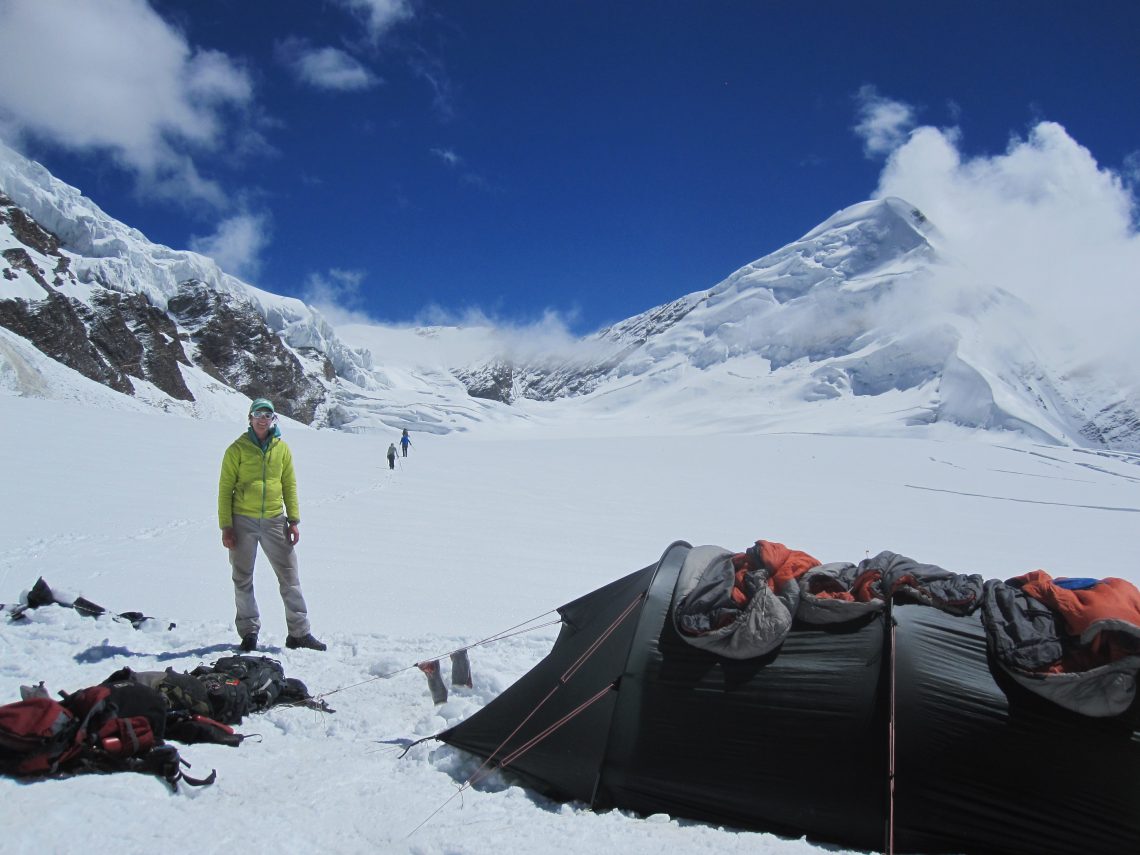See November 5th, 2016 post for NOLS Himalaya, Part 1: The Approach.
Surrounded by the Pindari River and the glaciated mountains, Zero Point is a gem, a Himalayan heaven. We spent 6 days at Zero Point from September 13, 2016 to September 18th, 2016. Our time was spent resting, doing laundry, bathing, learning various lessons, enjoying the incredible views, and preparing to move to Camp 1.
Since Loharkhet, we measured our O2 sats and heart rate daily. At Zero Point (~12,000 feet), my O2 sats were in the low 90’s and my heart rate was in the upper 60’s to mid 70’s. The nights were very chilly and I began to miss my dog, Fitz Roy. We were barely two weeks into the 6 week trip and the hard stuff was yet to come. As we sorted 3 weeks’ worth of food rations, I was about to experience my first taste of the “hard stuff.”
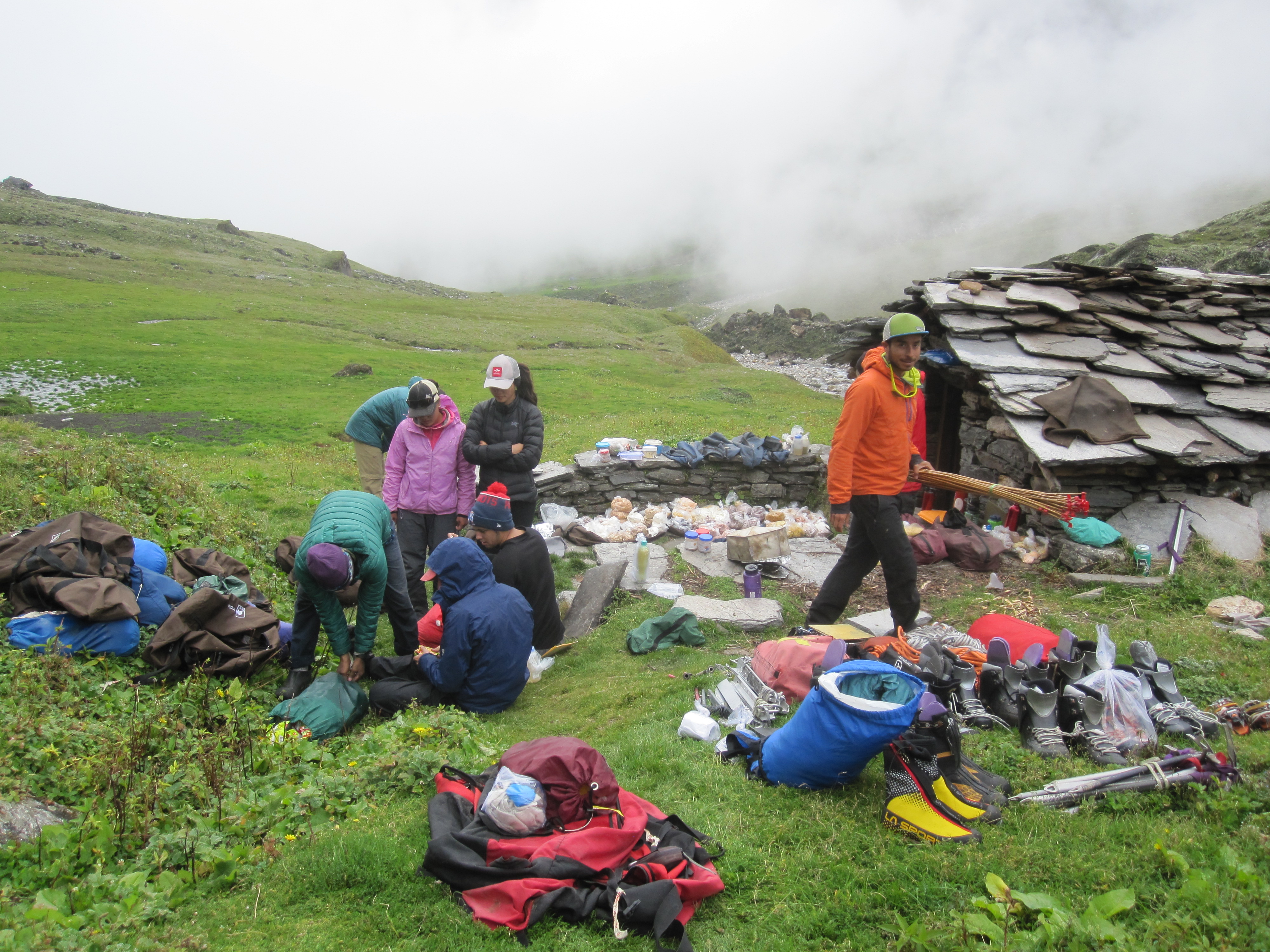
September 16th was ferry day. We moved our technical gear (mountaineering boots, ice axes, crampons, gamo bag, 3 ropes, 3 weeks’ worth of food, fuel, and other heavy stuff) from Zero Point to Camp 1. It was barely 2 miles to Camp 1, but we had around 2,000 feet of elevation to gain.

Ferry Day 1 was successful, but it was a rough day. Very steep terrain and high consequence if you lost your footing in spots. We would hike for 45 minutes, then break for 15. There were awesome views in the morning, which transformed into clouds and rain by the afternoon. We stashed our gear at Camp 1 and made our way back down to Zero Point with light packs. Light packs are the best! Baba Ji greeted us at Zero Point with a TON of food. We had roti, rice, chickpeas, cream of wheat, and gulab jamun. It was spectacular!
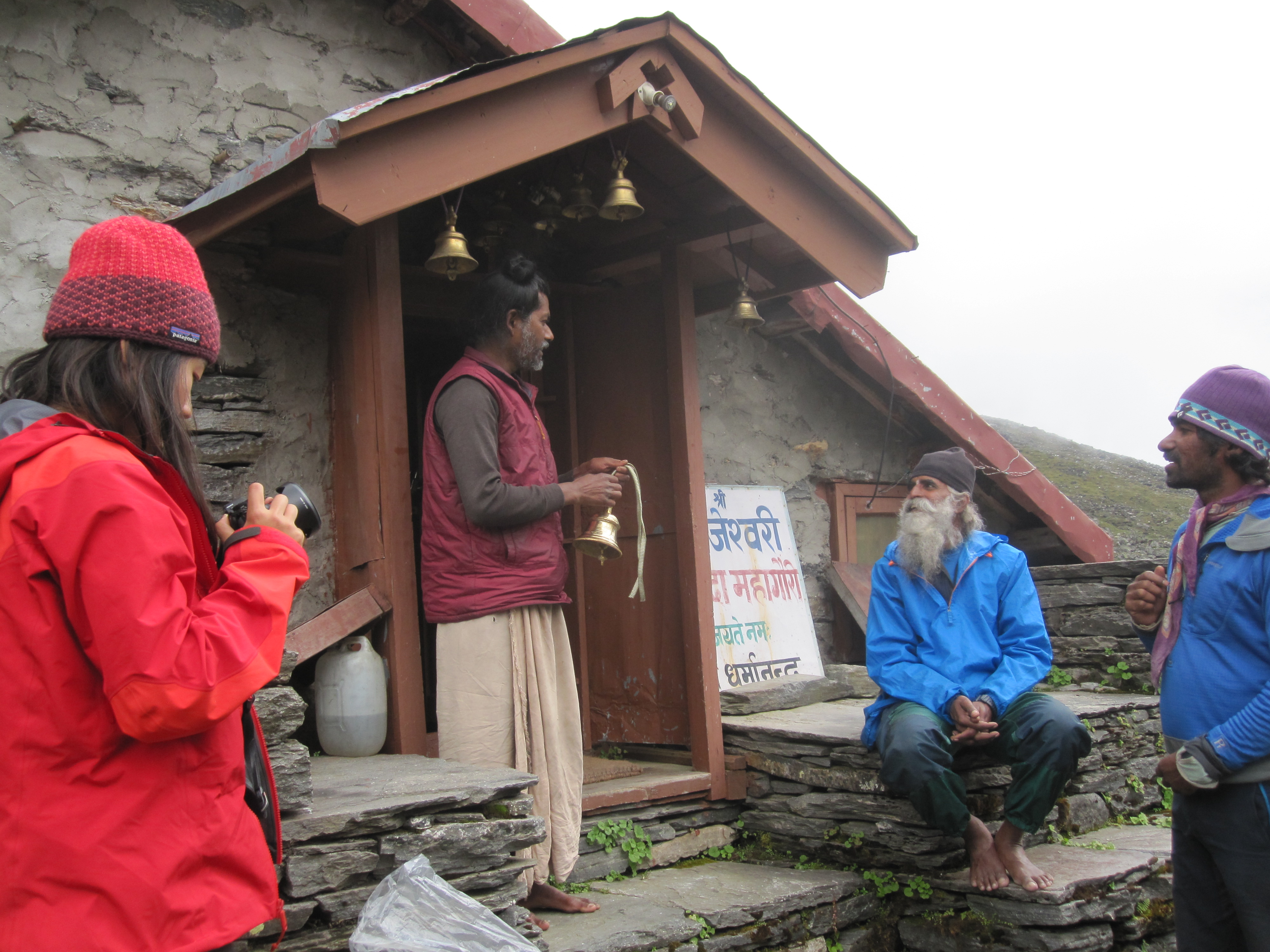
We rested September 17th. Even our rest days were filled with work as we learned knot tying skills and other lessons. This was our last night at Zero Point. We would be completely self-sufficient from here on out. No more Baba Ji or chai shops or baths or laundry days (in the freezing Pindari River) for the foreseeable future.
September 18th: Zero Point to Camp 1 (2 miles; 14,000 feet)
Baba Ji waved us off around 9 am. It was an incredible day as we left Zero Point. We decided to take a more “mellow” route to Camp 1, which turned out not to be so “mellow.” Mellow has a different meaning in the Himalayas than it does to a Southerner from Tennessee. Nevertheless, we trekked to Camp 1 and set up camp, where we would stay for another 6 days. It took us 5 hours to go 2 miles. Well, 2 miles according to our 1960’s map. It felt more like 10 miles.

I could feel the altitude. It was slow-moving and difficult to breathe at Camp 1. I tried not to think about it too much, as we had a lot more elevation to gain. During my time at Camp 1, I began to long for the comforts of a hot shower and warm bed. I tried to stay “in the moment,” but there were times when I wanted out. Out of my tent, out of the wilderness, out of India.
Those moments didn’t last too long though. Most of my thoughts centered around how to pack my backpack more efficiently, cooking/cleaning, collecting water, going to the bathroom, learning how to read that ridiculous 1960’s map, practicing knots, and learning rope skills needed to walk on a glacier. Basically my thoughts centered on survival and maintaining my health. It was imperative to stay “clean” and healthy as much as possible. I also took time to enjoy the views, the sunsets, and the Milky Way. I have never seen the Milky Way like it was in the Himalayas. Words can’t do it justice.
Pro Tip: Sleep with camera batteries close to you. The body heat extends the life of the battery in cold weather.

Our plan was to ferry to Camp 2 on September 20th, but hail forced a layover day at Camp 1. The layover day was spent making pancakes in our tent and dreaming of real food back home. I regretted not bringing Snickers bars on this trip. I also desperately longed for my iPod. It’s incredibly difficult to lay in a tent all day with 3 other people. I’ve never felt claustrophobic before, but I certainly did on this layover day.
September 21st: Ferry Day to Camp 2 (~1.5mile; ~2,000 feet elevation gain)
After scrambling up and down a steep moraine (a mass of rocks and sediment carried down and deposited by a glacier), we finally approached the glacier! It was a dry glacier so there was no need to rope up, just strap on crampons. I was elated! As we negotiated through the massive crevasse field, clouds began to build and visibility decreased. We eventually arrived at Camp 2, which was on another moraine. After stashing our food and gear, we made our way back to Camp 1 in the hail and rain. I kept rolling my ankle on the difficult terrain.

We got lost on the way back down to Camp 1. It was pea soup and our sight was limited. My stomach hurt. I was cold. I was wet. I was tired. I wanted to go home.
There were amazing moments on this trip and there were awful ones. This was an awful one.
Spirits were a little down, but we made it back to Camp 1. The following day was another layover day as hail kept us stationary. It was so cold, and I’m glad we didn’t move. My thoughts wandered to my dog, a hot drink, a hot shower, and access to a washer and dryer. I had time to think about the next ten days and what trials lay ahead. Everyone wanted to summit both passes; none of us wanted to turn around. I had to focus on the moment and make preparations for the next day. There was no use dwelling on what may or may not happen.

September 23rd: Move to Camp 2 (16,000 feet)
We woke to another brilliantly sunny (and freezing!) morning. Light snow covered the ground. There was a heaviness among the group; the feeling in the air was not excitement, but of dread. We all knew how hard the move to Camp 2 would be, but this time our packs were heavier. Felipe and Prani picked up on our mood rather quickly and tactfully told us to check our attitude. It’s imperative to be in the right frame of mind. The “pep talk” was much needed. We were in this insanely beautiful place, and yes, we had a difficult day ahead, but we needed to focus on our goals. We needed to suck it up.

I placed one foot in front of the other on the way to Camp 2. It was slow moving. It was hard to catch my breath, especially with a heavy pack. The weather changed so quickly: sun, snow, hail, and then sun again. After about 6 hours, we arrived at Camp 2. Then we had to set up camp and find water. Running water was difficult to come by at 16,000 feet.
Pro Tip: Use tent poles as a water spicket.
I was so glad to be in my sleeping bag in Camp 2. As I nodded off to sleep, I wondered about our group’s ability to make both passes. At least we would have several days at Camp 2 to rest and prepare to cross the first pass, Kafni Kol, at 17, 500 feet.
With Camp 2 as our base, we slowly advanced towards the Kafni Kol. Each day we made progress on the glacier and gained confidence in our mountaineering skills. Everything took extraordinary effort: finding water, cooking, cleaning, prepping to walk on the glacier, walking on the glacier, going to the bathroom. Again, breathing was a challenge; I felt like I was suffocating in between waves of nausea and also, homesickness. But, these were symptoms of mild altitude sickness and normal. Staying hydrated and eating were key to maintaining health.

Our expedition had a decision to make: What was our primary goal? Did we want to cross both passes and complete the traverse or focus on other technical skills and go back the way we came?
While I definitely did not want to backtrack, there were times I honestly did not want to cross the pass. If I was having this much difficulty at 16,000 feet, I wasn’t sure how I would handle 18,000 feet. Not to mention walking over harder terrain with our stupidly heavy packs.
However, when we discussed the options as a group, I voted for completing the traverse. Despite my apprehension, I wanted to finish what we started. September 30th was the deadline: Summit Kafni Kol with our food rations or be forced to turn around.
September 26, 2016: Ferry Day
Day 20 in the field. It was a beautiful, clear morning as we stepped out onto the glacier around 8:45 am. Our goal was to cross the Kafni Kol, stash our rations, and return to Camp 2 to rest and acclimate. Go high, sleep low. Everyone was excited and in good spirits. We divided into two rope teams of 5 and started on the same trail we walked the previous days. Prani and his rope team led the way. We slowly and steadily made forward progress.
Suddenly, Prani stopped. He called out for Felipe. Our rope team parallel parked by Prani’s on the glacier. The sun was bright and oppressive. Without glacier glasses, one would quickly go snow blind.
There was a huge crevasse that we could not circumnavigate. We had to descend into the crevasse, walk through it, and then climb out of it to continue to the Kafni Kol. The students waited as Prani and Felipe probed the glacier and set up protection. After what seemed like an hour or more, we made our way into the crevasse, one by one. It was stop and go as each person, zigzagged in and out of the crevasse.

Our weather window was closing. Every beautiful morning was followed by snow and hail in the afternoon. As we approached the base of the Kafni Kol onto a moraine, the clouds rolled in and the temperature dropped. We decided to stash our rations at the base of pass and head back to Camp 2. While I was glad to be headed back to Camp 2, this meant one of two things:
- We would have to pick up our rations as we moved to Camp 3 over the pass. So, SUPER heavy pack.
- We would have to cross the pass a second time to pick up our food rations.
Neither option seemed appealing to me.
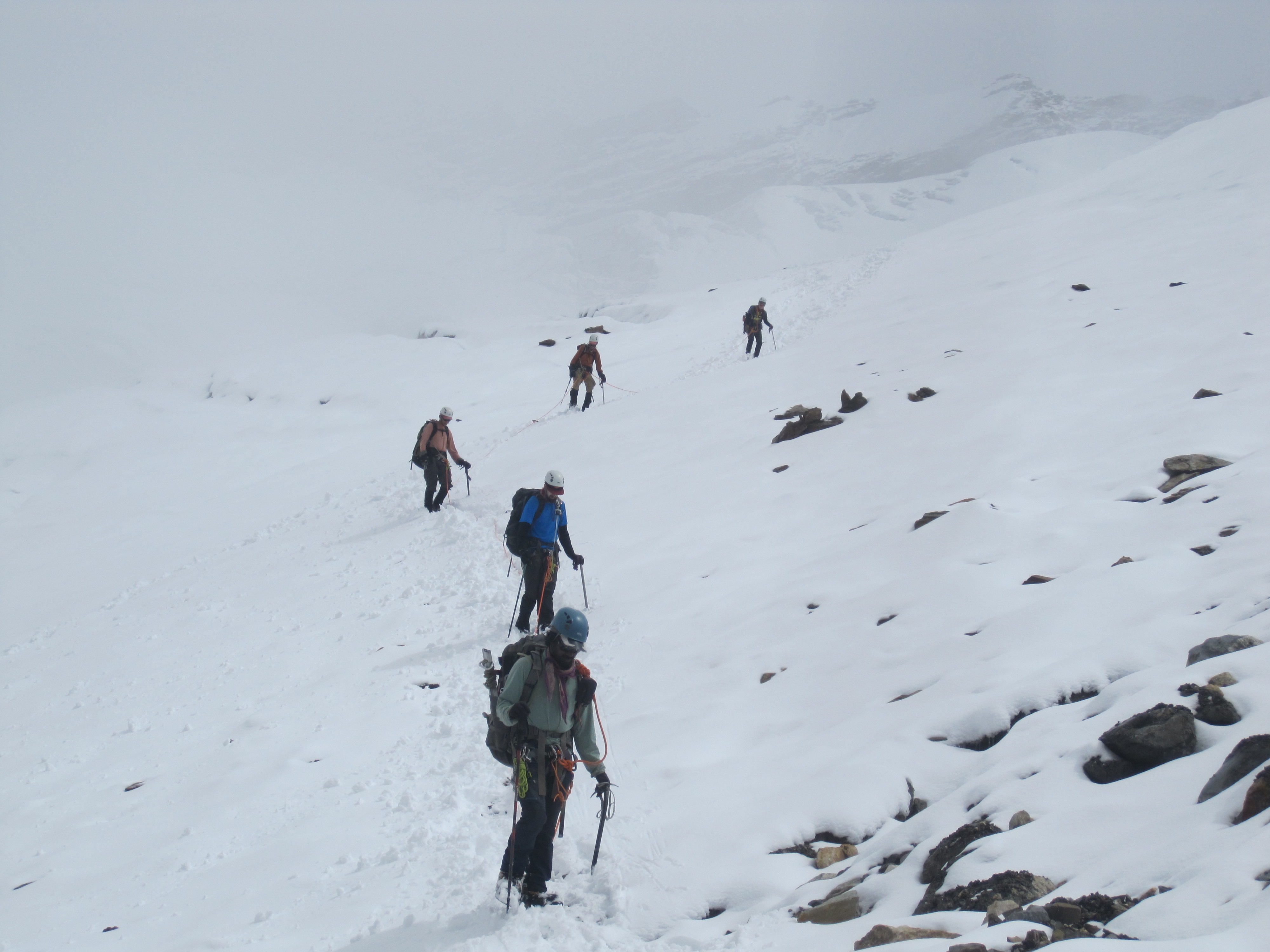
The following day was a rest day. We were confined to our tents for most of the day in whiteout conditions. As it snowed and hailed, I continued to long for a hot shower and clean clothes!
The weather eventually cleared and we enjoyed another spectacularly starry night. Avalanches and ice falls echoed in the distance. I saw a shooting star. I was thankful for my puffy pants and puffy coat.
On September 28th, we moved from Camp 2 to Camp 3, across the Kafni Kol (~2.5 miles). We did not pick up the rations at the base of the pass, which meant we would be forced to cross the pass a second time.
As we stepped onto the glacier at the base of the Kafni Kol, the clouds rolled in and I could no longer see the top. I could barely see anyone on my rope team. Prani’s team had kicked steps for us, so it was our job not to blow out the steps. I tried to focus on my breathing and not worry about how much farther we had to go. The Kafni Kol incline was a 45 degree slope. My legs burned with every step. As we approached the top of the pass, some steps had been blown out. I yelled to my rope team “zero,” which meant stop. I was struggling to move forward as I kept sliding down where the steps were gone, wasting energy. My legs screamed as I tried to hammer through the last part. Eventually, we reached the top of the pass! Woohoo! I was elated and high-fived everyone. It was steep. I was apprehensive. But we did it!

Even though we were celebrating, we still needed to descend and set up camp on the glacier. We were socked in and couldn’t see anything. The back side of the pass was moraine, so we unroped and made our way down the scree field to another glacier. We roped back up and headed onto the glacier to a compression zone. A compression zone is a safe place to camp on a glacier. I was freezing. I was over the day. But we still had to set up camp. GAH, this course just keeps getting harder! Prani and Felipe probed the glacier for crevasses and established a perimeter camp. We did not leave the perimeter unroped.
After an eternity of prepping camp, I finally crawled into my sleeping bag. Time to bring out the puffy pants and puffy jacket; it was freaking cold up here at 17,000 feet! I was happy to be in my tent ready to fall asleep, but I dreaded the next day. Our plan was to go back up and over the pass, grab our rations, and then back up and down the Kafni Kol to Camp 3. I really, really dreaded it.

As we woke the next morning and evaluated everyone’s mental and physical state, we elected to take a rest day. I was relieved, but we had a small window of time. We had to retrieve our rations and be over the pass by September 30th. So we had 1 more day to accomplish this feat or we’d be force to turn back the way we began.
On September 30th, we went over the Kafni Kol for a second time and picked up our food rations. I was so glad I went! The views were incredible! It was a crystal clear day. I felt relief as we entered Camp 3 again. We had our food rations and were prepared to cross Dhana Dura, the second pass, at 18,500 feet.

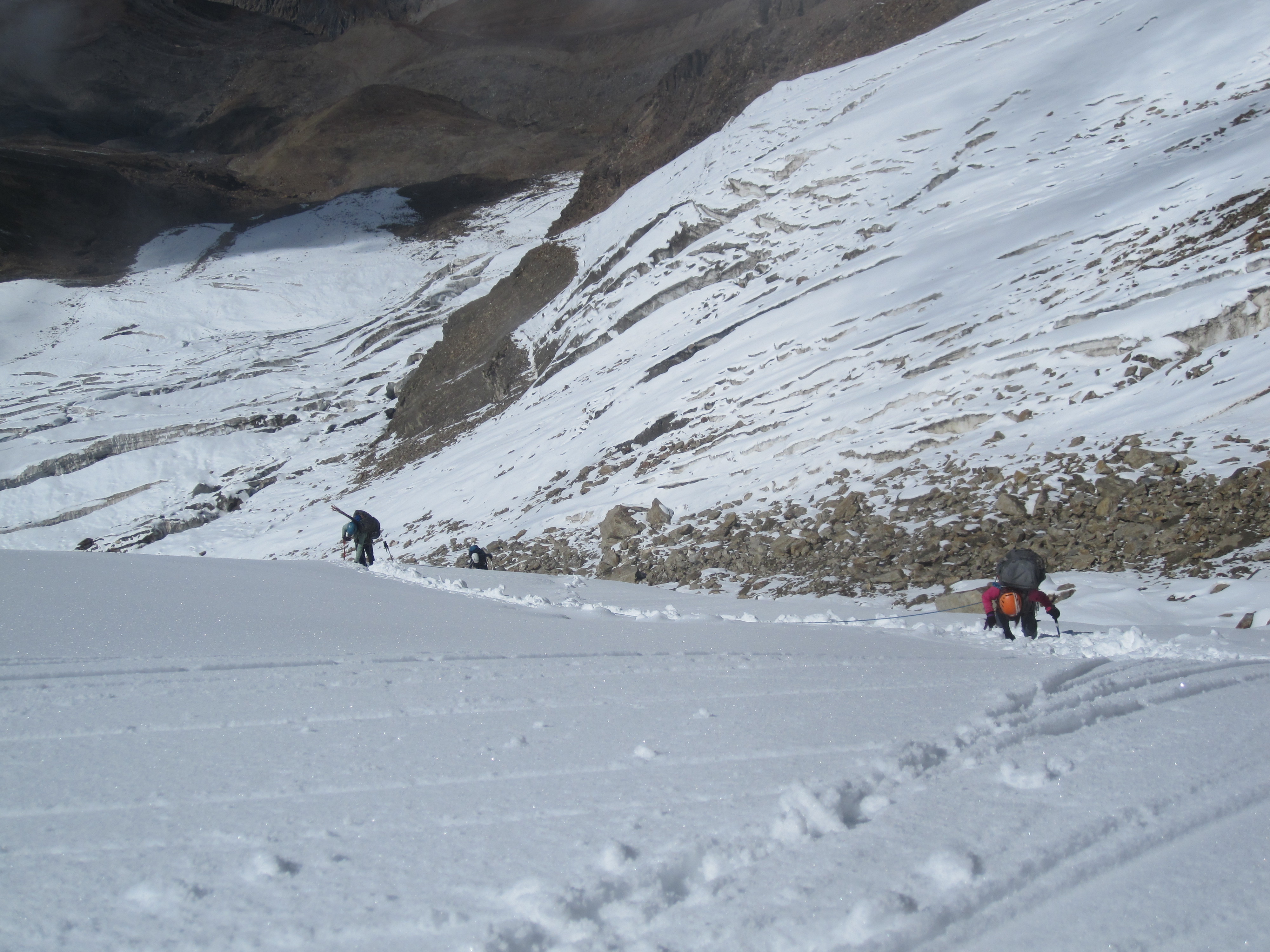
Spirits were high despite the brutal living conditions of the glacier (and we were lucky enough to have good weather!). It takes an enormous amount of effort to exist on a glacier. I was longing for the comforts of Camp 2. We melted ice for water ALL day long just to stay hydrated. It was too cold to cook outside the tent, so we learned how to cook in the vestibule.

On October 1st, we headed towards the Dhana Dura pass not knowing if we would camp below the pass or cross it. We waited at 18,000 feet while Prani and Felipe scouted the route and placed protection. From where we stood, it appeared there were two potential ways to cross. The route to the left, while technical, looked a little more mellow than the route to the right. After hours of scouting the left route, Felipe and Prani determined it was impassable. Huge crevasses lay just over the top. We were forced to make camp at 18,000 feet as the daylight dwindled.

Camping at 18,000 feet was a surreal experience. We were above the clouds, on top of the world, in what appeared to be some sort of alien planet. We were visitors in this extraordinary land, just passing through, thankful to get a glimpse of a world few people have ever seen. And the sunset. Oh my gosh, the sunset.
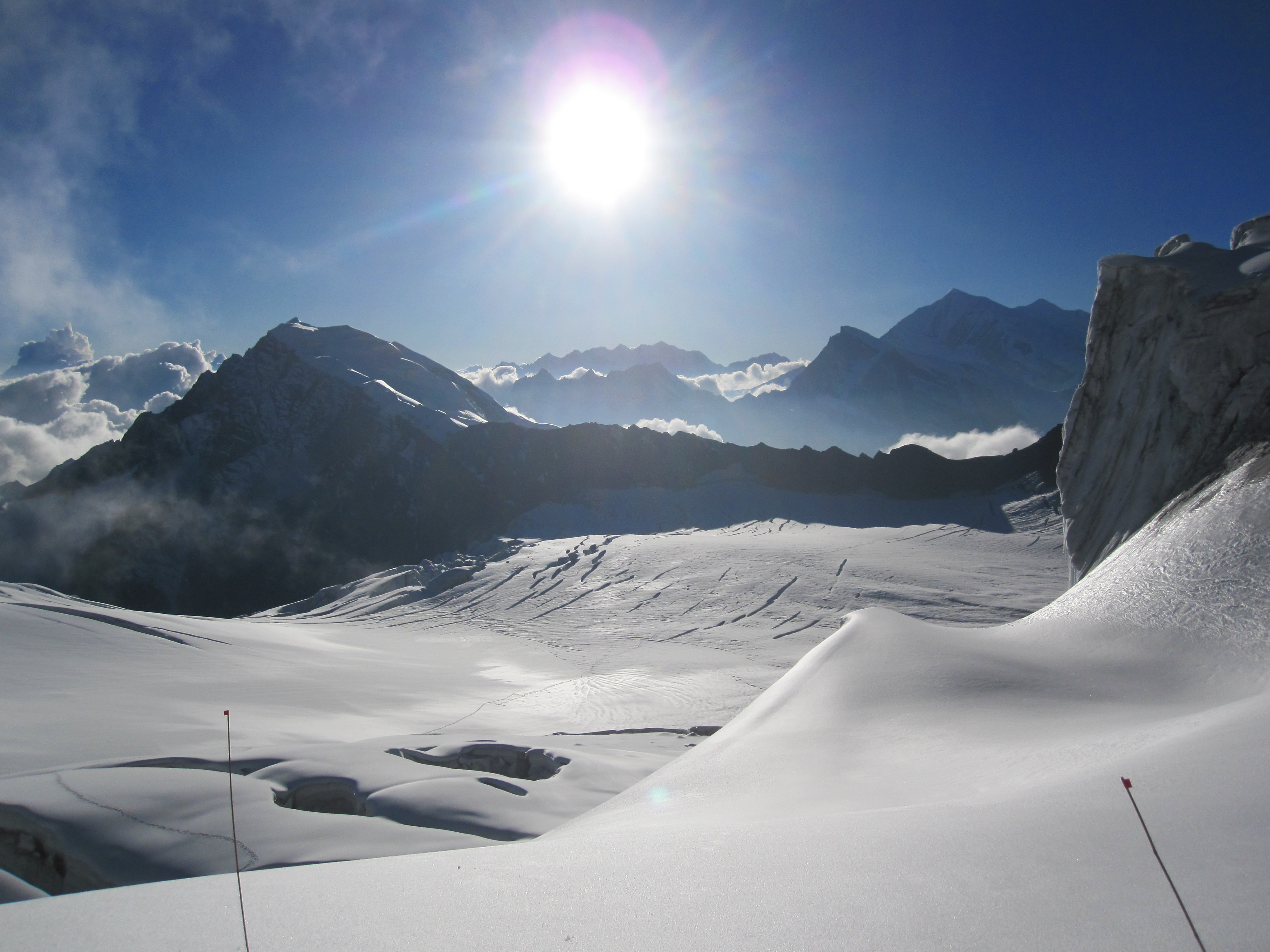
On October 2nd, we awoke with the goal of crossing Dhana Dura from the right side. It was steeper than the Kafni Kol and the consequence of falling was higher, at least from my amateur perspective.
We were moving in 3 rope teams now. Prani led a rope team of 3, then a 4 person student-led rope team followed, and then my rope team of 3 swept the route. My team rested and waited as Prani kicked steps and established the protection. We used ice pickets to clip into for added protection, in case of a fall.

It was a good 45 minutes or so before our team moved. As we waited, the student-led rope team had a member punch a hole through a crack. He fell down to his waist. It didn’t require any formal rescue and he pulled himself up. I can’t imagine how much effort it took to pull himself out…at that altitude…with a 65 pound pack.

Speaking of packs, my pack was the heaviest it had been since the start of the trip. I am convinced my pack weighed close to 70 pounds that day.
I led the final rope team up the 50 degree incline of the Dhana Dura. I didn’t look down or up, I just focused on each step and clipping through the carabiners attached to the ice pickets buried in the snow. I moved excruciatingly slow, but that’s all I could do. I loosened my top chest strap because it felt like I was suffocating. About half way up the slope, my stomach began to hurt. I’ll spare you the details (it was another awful moment), because nothing was going to take away from the glorious moment of reaching the top of the pass. As we stepped towards the top and reached the other two rope teams, I was ecstatic!

Then someone broke the news to me; it was a false summit. Dhana Dura was just ahead of us. It looked a bit easier, but finished with a steep rock scramble towards the top. We moved forward and eventually reached the top of Dhana Dura at 18,500 feet. We hugged, high-fived and celebrated our accomplishment! I was relieved and felt the hardest parts were over.

After all, it was all downhill from here on out. Oh, but I was so wrong…

Check back soon for Part 3: The Descent!

